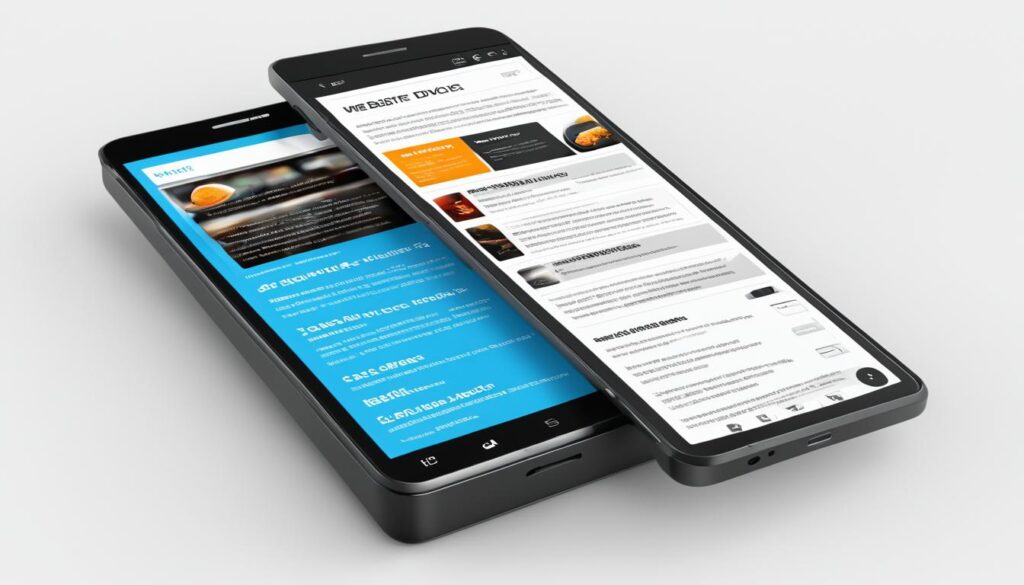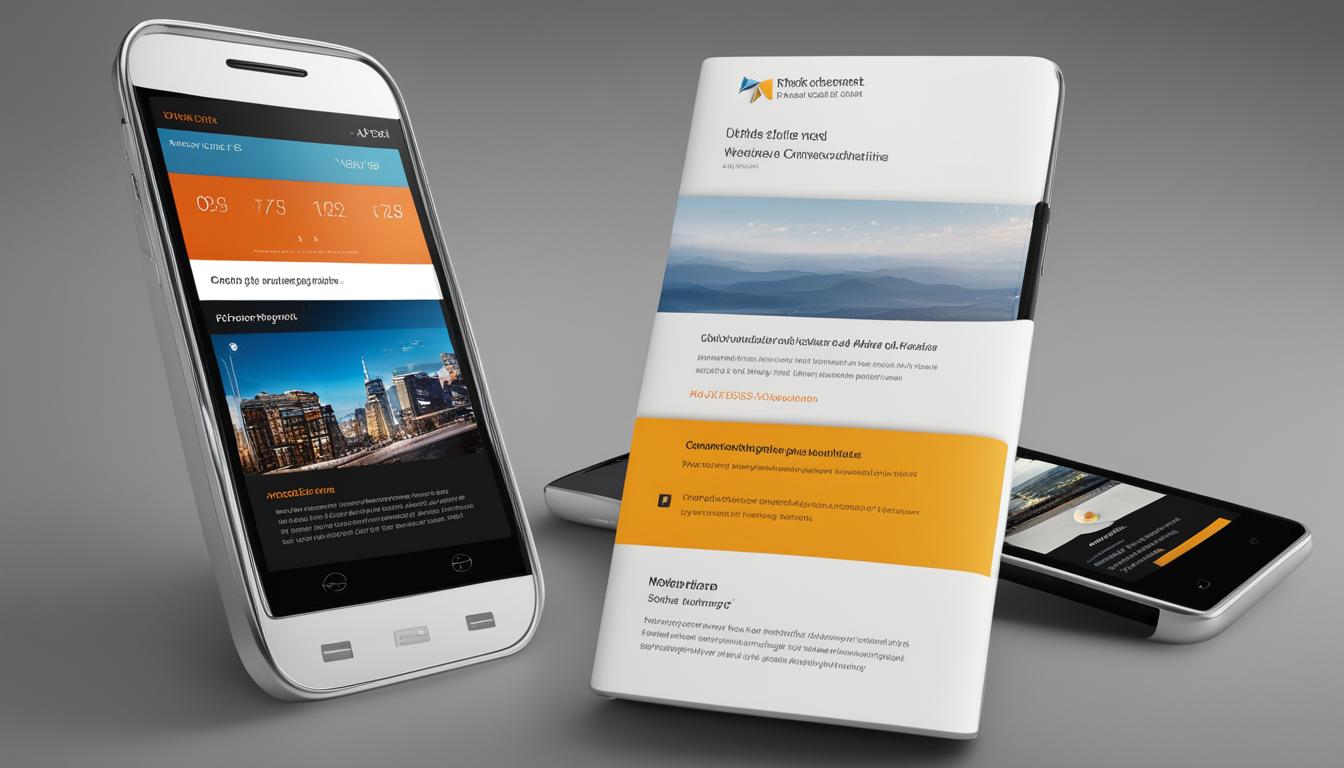As we continue to witness the widespread usage of smartphones for internet browsing, it becomes imperative for businesses to prioritize web design for mobile devices. With approximately 60% of internet traffic originating from mobile devices, according to a report from Statcounter, creating mobile-friendly websites is essential to reach and engage with customers effectively. Moreover, having a mobile-friendly website not only improves search engine rankings but also provides users with an enhanced viewing experience on their smaller screens.
Implementing responsive layouts, optimizing website speed, compressing images, using HTML5 instead of Flash, avoiding pop-ups, and optimizing button size and placement are some of the best practices to make your website mobile-friendly. By adhering to these techniques, businesses can ensure their online presence remains optimized for mobile devices and create a satisfying user experience for their target audience.
Key Takeaways:
- Creating mobile-friendly websites is crucial to reach customers in today’s mobile-driven world.
- About 60% of internet traffic comes from mobile devices.
- A mobile-friendly website improves search engine rankings and provides a better viewing experience.
- Responsive layouts, website speed optimization, image compression, and optimized button size and placement are essential techniques for mobile-friendly web design.
- By following best practices, businesses can enhance their online presence and engage with a wider audience on mobile devices.
The Importance of Mobile-Friendly Websites
A mobile-friendly website is crucial in today’s digital landscape. With over 60% of internet traffic coming from mobile devices, optimizing your website for mobile use is essential for reaching and engaging with customers. A mobile-friendly website improves the user experience, increases search engine visibility, and can lead to higher conversions and sales. By providing a seamless and user-friendly experience on mobile devices, we can effectively engage with our target audience and stay ahead in the competitive market.
As the number of mobile users continues to grow, businesses need to prioritize mobile web development to cater to their needs. A mobile-friendly website ensures that visitors can easily navigate, read content, and take action on their mobile devices. This enhanced user experience not only keeps visitors on our website longer, but it also improves our chances of converting them into paying customers.
“Having a mobile-friendly website is no longer an option—it’s a necessity. If our website isn’t mobile-friendly, we risk losing potential customers to our competitors who provide a better mobile experience.”
In addition to improving user experience, a mobile-friendly website also plays a significant role in search engine optimization. Search engines prioritize mobile-friendly websites in their rankings, making it easier for potential customers to discover our business. By incorporating mobile web development best practices and ensuring our website is responsive and optimized for mobile devices, we can improve our search engine visibility and attract more organic traffic.
Investing in mobile-friendly websites is not just about meeting the expectations of mobile users—it’s about staying relevant in an increasingly mobile-driven world. By providing a seamless and user-friendly experience on mobile devices, we can position ourselves as a trusted and innovative brand that values customer satisfaction. Don’t miss out on the incredible opportunities that mobile brings. Let’s optimize our website for mobile, enhance the user experience, and make the most of this digital revolution.
What is a Mobile Website?
A mobile website is a site that is specifically designed and optimized for mobile devices such as smartphones and tablets. It has a simplified design and layout that makes it easy to navigate and use on smaller screens. Mobile websites can have a mobile-specific URL, or they can adapt to the screen size of the device through responsive design. A mobile website provides a tailored user experience for mobile users and ensures that the content is easily accessible and readable on mobile devices.
Benefits of Mobile-Friendly Websites
Mobile-friendly websites offer numerous benefits for both businesses and users. Our mobile-first approach ensures that your website provides an exceptional user experience on mobile devices, improving engagement and conversions.
For businesses, a mobile-friendly website enhances the overall online presence, making it easier to reach a wider audience. With a seamless and user-friendly experience, users can easily navigate your website, read content, and perform actions such as making a purchase or contacting your business.
But the benefits go beyond just user experience. A mobile-friendly website also improves search engine visibility. Search engines prioritize mobile-friendly websites in their rankings, giving you an edge over your competition and driving more organic traffic to your site.
“Having a mobile-friendly website is no longer an option. It’s a necessity. With the majority of internet traffic coming from mobile devices, businesses that neglect to have a mobile-friendly website are missing out on a significant amount of potential customers.” – Julie Johnson, CEO of Mobile Solutions Co.
Furthermore, a mobile-friendly website can lead to higher conversions. By providing a seamless and user-friendly experience, you create a positive impression of your brand and make it easier for users to take the desired actions on your site, whether it’s making a purchase, submitting a contact form, or signing up for a newsletter.
Investing in a mobile-friendly website is essential in today’s digital landscape. With our expertise in mobile web design, we can help you unlock the full potential of your online presence, ensuring that your website is optimized for mobile devices, provides an exceptional user experience, and drives conversions.

Mobile-Friendly Websites: By the Numbers
| Statistic | Percentage |
|---|---|
| Percentage of internet traffic from mobile devices | 60% |
| Mobile users who leave a website if it’s not mobile-friendly | 74% |
| Mobile users who are more likely to convert on a mobile-friendly website | 67% |
| Mobile sites that rank higher in search engine results | 70% |
Designing a Mobile-Friendly Website
Designing a mobile-friendly website requires a thoughtful approach and consideration of key factors that enhance the user experience on mobile devices. One of the most crucial elements is responsive design, which ensures that the website adapts seamlessly to different screen sizes and devices, enhancing accessibility and usability.
When implementing responsive design, it is important to pay attention to simplified navigation. Mobile users appreciate intuitive and streamlined navigation that guides them effortlessly through the website. By reducing clutter and minimizing menu items, you can create a user-friendly experience that allows visitors to easily find what they are looking for.
Additionally, using large buttons is essential for mobile web design. Mobile screens are smaller, making it important to provide buttons that are easy to tap. Large buttons prevent accidental clicks and improve the overall usability of the website. They also contribute to an aesthetically pleasing design that prioritizes user experience.
Optimizing images plays a vital role in mobile web design. Images should be compressed and properly formatted to ensure quick loading times, preventing delays that can frustrate mobile users. By optimizing images, you can create a seamless browsing experience and enhance user satisfaction.
Implementing a mobile-friendly design that incorporates responsive design, simplified navigation, large buttons, and optimized images is crucial for creating a website that provides an excellent user experience on mobile devices. By prioritizing these key elements, businesses can effectively engage their mobile audience and establish a strong online presence.
When designing a mobile-friendly website, our goal is to create a seamless user experience that caters to the unique needs and expectations of mobile users. By following these best practices for mobile web design, we can ensure that our websites are visually appealing, easy to navigate, and optimized for mobile devices.

| Best Practices for Designing Mobile-Friendly Websites |
|---|
| Use responsive design to adapt to different screen sizes and devices |
| Simplify navigation for easy browsing |
| Utilize large buttons for easy tapping |
| Optimize images for quick loading |
Best Practices for Mobile Website Design
When it comes to mobile website design, following best practices is crucial to ensure a seamless and user-friendly experience. By implementing a simplified and clean design, incorporating large buttons, optimizing images, and utilizing responsive design, businesses can create mobile-friendly websites that engage and convert users effectively.
- Simplified Design: Create a clean and clutter-free design that focuses on the most important content. A simplified design ensures faster loading times and helps users navigate the website effortlessly on their mobile devices.
- Large Buttons: Use large and easily-tappable buttons to enhance user experience. Mobile screens require buttons that are big enough to tap accurately, reducing the risk of frustrating errors.
- Optimized Images: Compress and optimize images to minimize file size without sacrificing quality. This ensures that images load quickly on mobile devices and contribute to a faster overall browsing experience.
- Responsive Design: Implement responsive design to ensure that your website adapts seamlessly to different screen sizes and devices. This approach guarantees that your website looks and functions flawlessly on smartphones, tablets, and other mobile devices.
Furthermore, there are additional best practices that can further enhance the mobile user experience:
- Avoiding pop-ups that hinder navigation and disrupt the user experience.
- Utilizing GPS directions for physical locations to provide users with easy navigation to your store or office.
- Simplifying forms for easy completion on mobile devices, reducing friction for users.
By implementing these best practices, businesses can create a mobile-friendly website that not only provides an excellent user experience but also maximizes engagement and conversions.
The Impact of Best Practices
Implementing best practices for mobile website design ensures a seamless user experience that can lead to higher engagement and conversions. By prioritizing mobile web design, businesses can gain a competitive edge in the increasingly mobile-driven digital landscape.
| Benefits of Best Practices for Mobile Website Design |
|---|
|

Google Analytics for Mobile Website Optimization
Google Analytics is an invaluable tool for optimizing your mobile website and enhancing the user experience. By tracking user behavior and analyzing data, you can gain valuable insights into how users interact with your website on their mobile devices. This data allows you to make informed decisions and implement changes that will improve engagement and drive conversions.
With Google Analytics, you can track a variety of metrics that are relevant to mobile website optimization. Here are some key data points you can gather:
- The number of mobile visitors to your website
- How users navigate through your mobile site
- The pages on your website that receive the most mobile traffic
- The average time users spend on each page
- Conversion rates for mobile visitors
By analyzing this data, you can identify areas where your mobile website may be underperforming and make targeted improvements. For example, if users are spending a relatively short amount of time on a particular page, you can investigate whether the content is engaging or if there are any technical issues that may be causing them to leave.
“Google Analytics provides valuable insights into user behavior on your mobile website, helping you make informed decisions to optimize the user experience and drive results.”
Google Analytics provides valuable insights into user behavior on your mobile website, helping you make informed decisions to optimize the user experience and drive results.
Here is an example of a Google Analytics Dashboard for Mobile Website Optimization:
| Metric | Description |
|---|---|
| Number of Mobile Visitors | The total number of users who accessed your website through a mobile device. |
| Average Time on Page | The average amount of time users spend on each page of your mobile website. |
| Mobile Conversion Rate | The percentage of mobile visitors who complete a desired action, such as making a purchase or submitting a form. |
By regularly monitoring and analyzing these metrics, you can identify trends and patterns that can inform your mobile website optimization strategy. For example, if your mobile conversion rate is lower than desired, you can focus on improving the checkout process or streamlining form submissions to increase conversions.
Furthermore, Google Analytics allows you to segment your data, providing insights into specific user groups. By analyzing data from different devices, locations, or demographics, you can tailor your mobile website optimization efforts to specific audience segments.
Make Data-Driven Decisions
Google Analytics empowers you to make data-driven decisions when it comes to optimizing your mobile website. By understanding how users engage with your site, you can identify areas for improvement and implement changes that will enhance the user experience.
For example, if you notice that a significant number of users are leaving your mobile website after viewing a specific page, you can investigate further. Perhaps the page takes too long to load, or the layout and content aren’t engaging enough. By making data-driven changes, such as optimizing page load speed or improving the design, you can reduce bounce rates and keep users engaged.

By leveraging the insights provided by Google Analytics for mobile website optimization, you can create a mobile experience that keeps users engaged, drives conversions, and ultimately increases your website’s success on mobile devices.
Optimizing Mobile Email Campaigns
With the majority of emails now being opened on mobile devices, it is crucial for businesses to optimize their email campaigns for mobile users. By implementing responsive design, simplifying the layout, and using large and legible fonts, we can ensure that our messages are effectively delivered and easily readable on mobile devices. This optimization strategy not only enhances the user experience but also leads to higher engagement and conversions.
Responsive design plays a key role in optimizing mobile email campaigns. By creating emails that adapt to different screen sizes, we can ensure that our messages are displayed correctly and effectively on any mobile device. Whether it’s a smartphone or a tablet, the responsive design adjusts the layout and content to provide an optimal viewing experience for recipients.
Simplifying the layout is another essential aspect of mobile email optimization. Mobile screens are smaller, and users often access their emails while on the go. By streamlining the layout and removing any unnecessary elements, we can make it easier for recipients to read and engage with our emails. A clean and simplified layout ensures that the main message stands out and eliminates any distractions that could hinder the user’s attention.
Utilizing large and legible fonts is crucial for mobile email readability. Small fonts can be hard to read on mobile screens, causing recipients to lose interest or struggle to understand the content. By using larger fonts, we can make sure that our emails are easily readable, even on smaller screens. This helps to capture recipients’ attention and convey our message effectively.
“Optimizing our email campaigns for mobile devices is a game-changer. It allows us to reach our audience effectively and deliver our message with impact. By creating emails that adapt to different screen sizes, simplifying the layout, and using large fonts, we can ensure that our recipients have a seamless and enjoyable experience with our brand.”
By adopting these optimization techniques, we can maximize the impact of our mobile email campaigns. Ensuring that our messages are well-designed and easily readable on mobile devices enables us to engage with our audience effectively and drive higher conversions. With the ever-increasing use of mobile devices, it is vital for businesses to prioritize mobile email optimization to stay ahead in today’s digital landscape.

Testing and Regular Maintenance
Regular testing and maintenance are vital for ensuring that your mobile website continues to deliver a seamless user experience. By conducting thorough mobile website testing on various devices and operating systems, you can identify and address any issues or inconsistencies that may arise. This proactive approach allows you to provide a consistent and optimized experience for your users, regardless of their chosen device.
Through regular updates, you can address performance and compatibility issues promptly, ensuring that your mobile website remains functional and user-friendly. Additionally, by incorporating new features and improvements into your website, you can stay ahead of the competition and provide an enhanced user experience.
Maintaining a robust and optimized mobile website requires ongoing attention and care. By consistently testing and optimizing your mobile website, you can guarantee that it meets the evolving needs of your audience and maintains its effectiveness in delivering a seamless user experience.
Benefits of Regular Maintenance
- Improved User Experience: Regular maintenance ensures that your mobile website remains fast, responsive, and easy to navigate, providing users with a positive and enjoyable experience.
- Enhanced Performance: By regularly optimizing performance metrics such as load times and page speed, you can keep your mobile website running smoothly, reducing bounce rates and increasing engagement.
- Increased User Satisfaction: With a well-maintained mobile website, you can meet user expectations and provide a high level of satisfaction, resulting in repeat visits and improved brand loyalty.
- Effective Bug Detection and Resolution: Regular maintenance allows you to identify and fix any bugs or glitches that may affect the functionality and usability of your mobile website, ensuring a seamless experience for your users.
By prioritizing regular testing and maintenance, you can uphold the quality and performance of your mobile website, providing your users with an exceptional experience that reflects positively on your brand and drives conversions.

Conclusion
In conclusion, optimizing your website for mobile devices is essential in today’s digital landscape. With the majority of internet traffic coming from mobile devices, businesses cannot afford to overlook the importance of mobile website optimization. By implementing responsive design and following best practices such as simplifying navigation and optimizing images, you can create a user-friendly experience that engages your mobile audience.
A mobile-friendly website not only improves your search engine visibility but also enhances the overall user experience. Mobile users expect websites to load quickly, have clear and easy-to-understand content, and provide intuitive navigation. By prioritizing responsiveness and user-centric design, you can ensure that your website meets these expectations and delivers a seamless browsing experience.
Regular testing and maintenance are crucial to ensure that your mobile website is always performing at its best. By analyzing data from tools like Google Analytics, you can gain valuable insights into user behavior and make informed decisions to optimize your website further. Remember, user experience is key to driving engagement and conversions on mobile devices.
Investing in web design for mobile devices and mobile website optimization is an investment in the future success of your business. By embracing responsive design and prioritizing user experience, you can create a mobile-friendly website that captivates your audience, improves your search engine rankings, and helps you stay competitive in today’s mobile-first world.
FAQ
Why is it important to have a mobile-friendly website?
Having a mobile-friendly website is important because it improves user experience, increases search engine visibility, and can lead to higher conversions and sales.
What is a mobile website?
A mobile website is a site that is specifically designed and optimized for mobile devices such as smartphones and tablets.
What are the benefits of having a mobile-friendly website?
Mobile-friendly websites provide a seamless and user-friendly experience, improve search engine visibility, and can lead to higher engagement and conversions.
What should I consider when designing a mobile-friendly website?
When designing a mobile-friendly website, it is important to use responsive design, simplify navigation, use large buttons, and optimize images for quick loading.
What are the best practices for mobile website design?
Best practices for mobile website design include using a simplified and clean design, using large buttons, optimizing images, and using responsive design to adapt to different screen sizes and devices.
How can Google Analytics help with mobile website optimization?
Google Analytics allows businesses to track user behavior on their mobile websites, providing insights into user preferences and engagement patterns to make informed optimization decisions.
How can I optimize my mobile email campaigns?
Mobile email campaigns can be optimized by using responsive design, simplifying the layout, and using large and legible fonts for easy reading and navigation on mobile devices.
Why is testing and regular maintenance important for a mobile website?
Testing and regular maintenance are important to ensure that a mobile website continues to provide a seamless user experience and remains optimized for mobile devices.

Leave a Reply